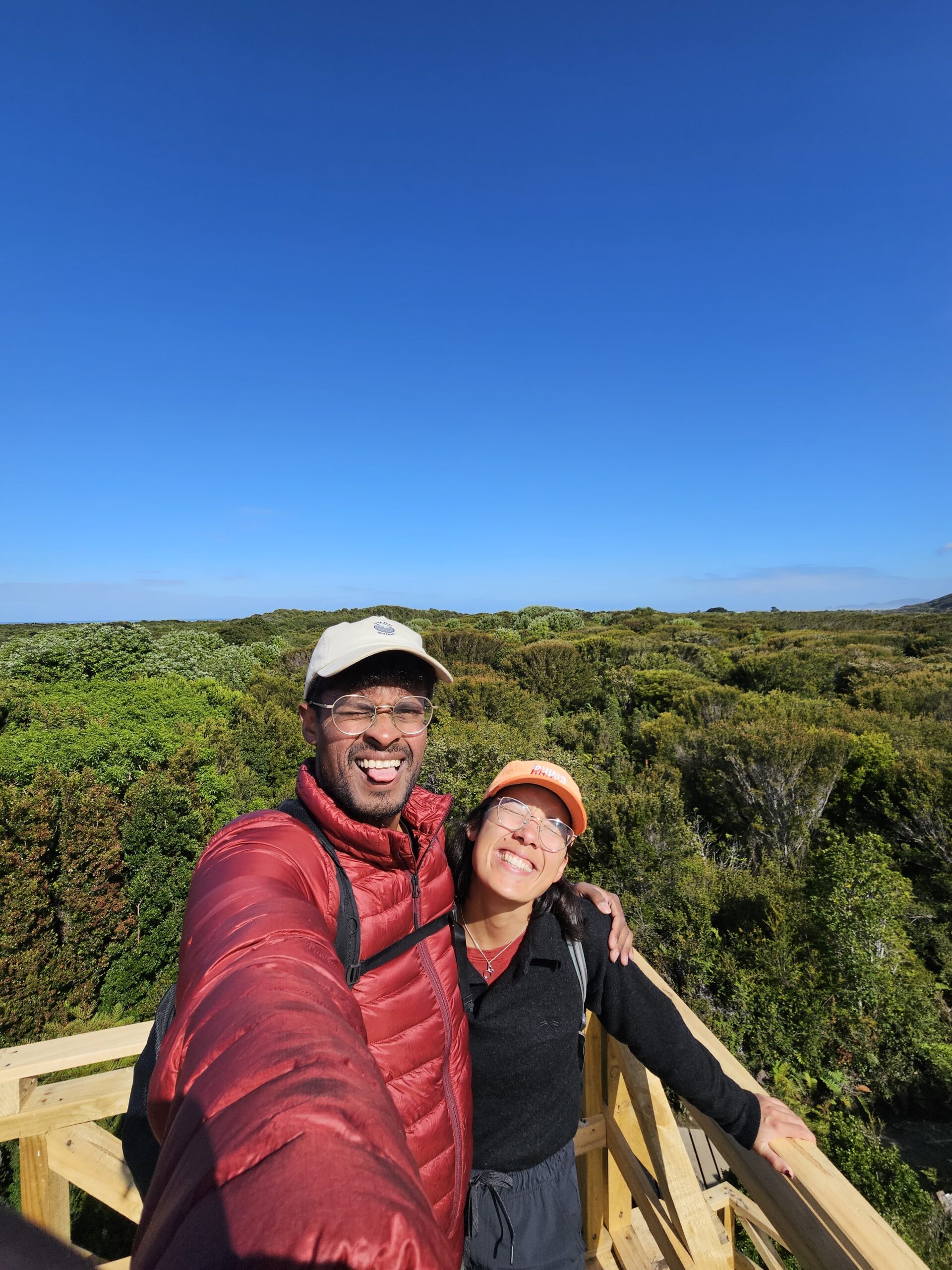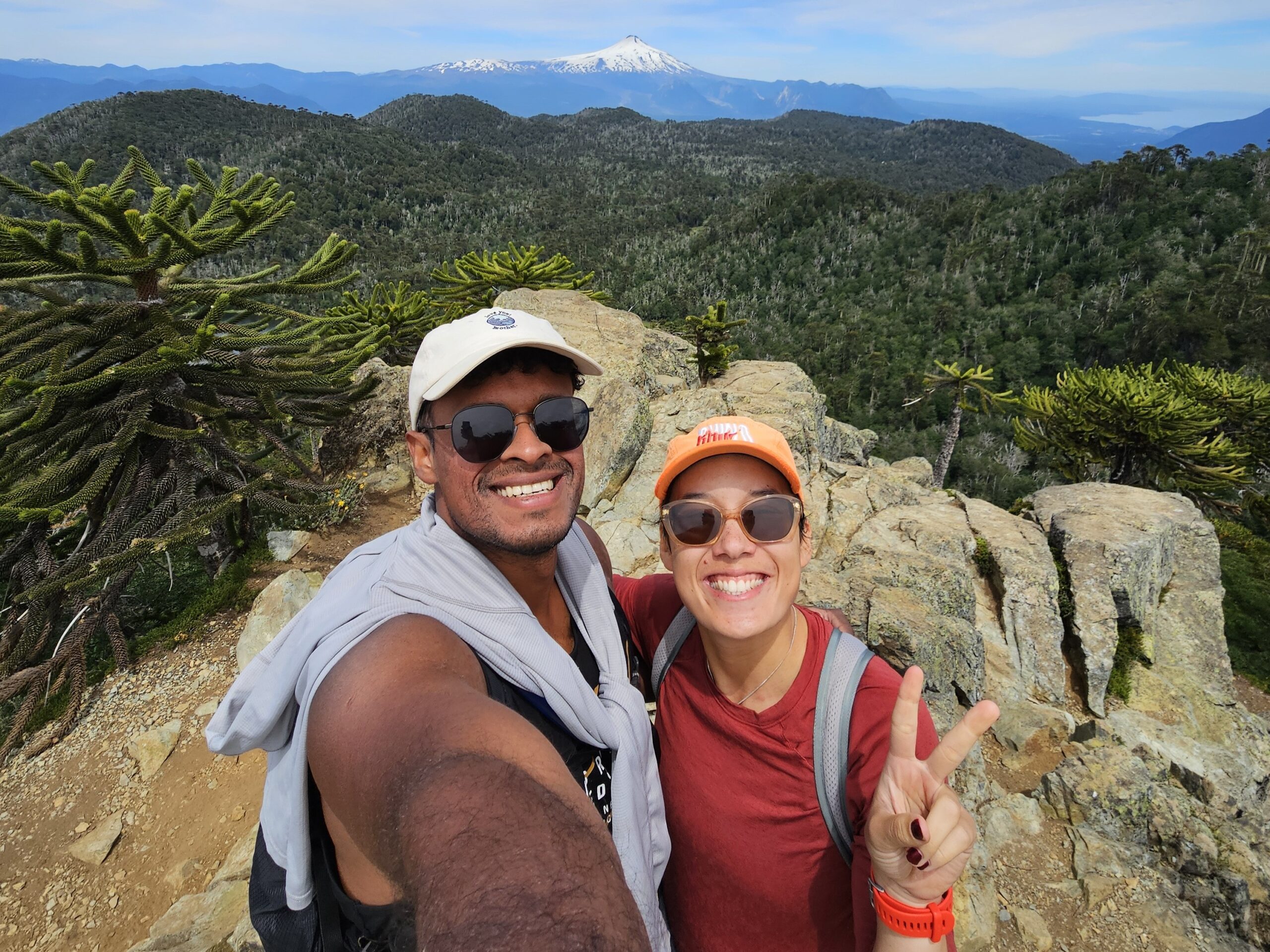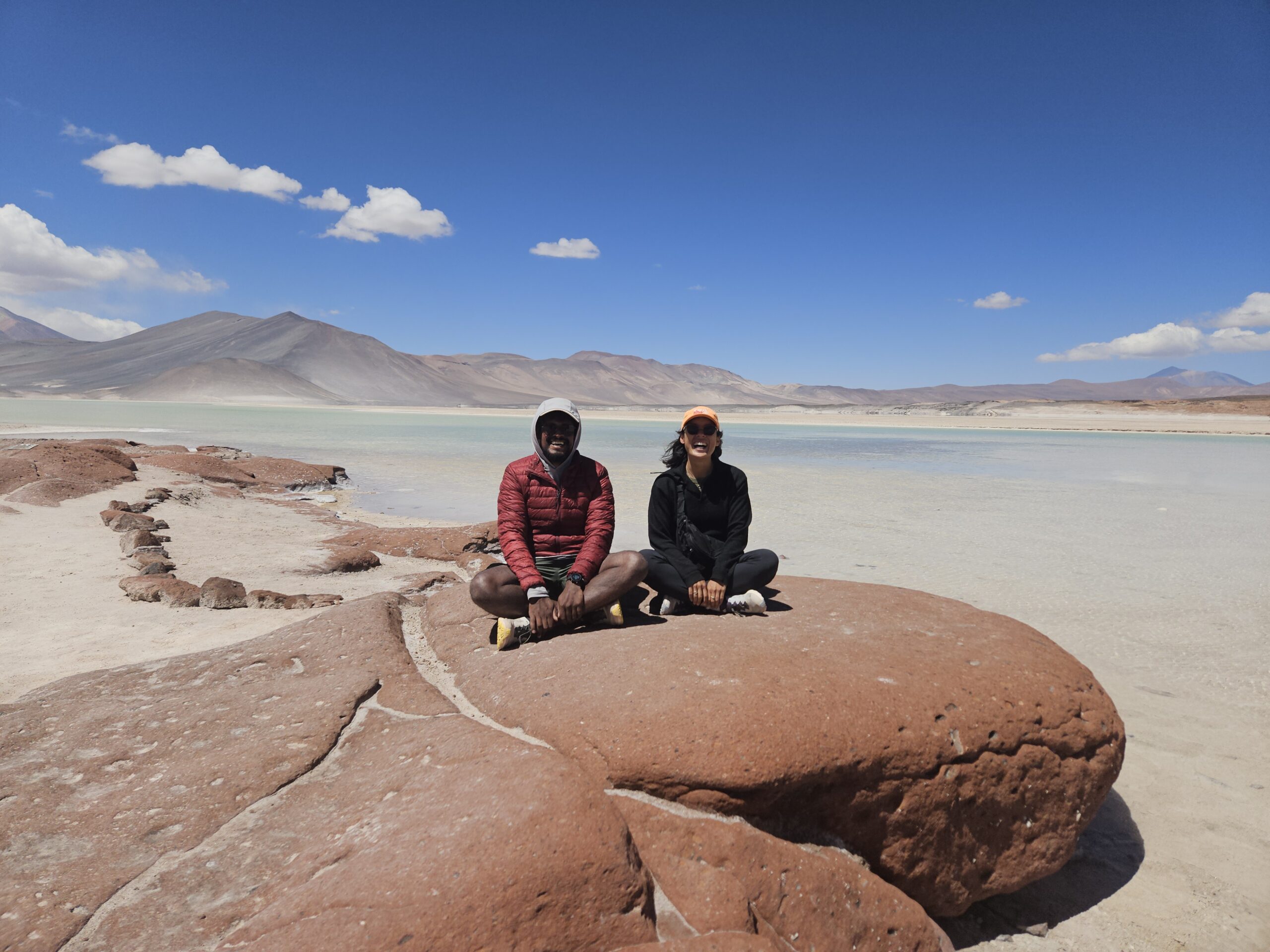Post hitchhike and 5 day trek on the Villarica Traverse, we had no set plans and were a little frazzled. What do we do? Where do we go? How do we get there? What are we doing here, anyway…? That was a wee learning for us – after a big hike, don’t try to make too many decisions, or rush out to the next stop (especially if it’s your first hike in 9 months!). The difficulty was doubled as we arrived back in Pucon the day before the Pucon 70.3 Ironman began (“the most scenic Ironman in the world”), so the town was extra full.
We had a list of “this sounds mean” for the next stop. Budi Lago and its surrounds to get an insight into Mapuche culture in modern times. Valdivia for a riverside breeze, fish markets and German influence. Castro for stilt houses, great seafood and local mythology. Puerto Varas for more beautiful lakesides, cute cafes and fabulous kuchen. Or maybe a little road trip through the top of the Carretera Austral, for our first Patagonian hiking experience.
Just look at that list! We had two weeks to travel, and over a month’s worth of things we wanted to do, several of which required hiring a car or some awkward bus heavy travel days.
Click here to take yourself to ‘Keep it Short and Sweet’ at the bottom of this page which summarizes this blog post.
Tell me everything:
What we did:
Valdivia
Turns out that booking accommodation for your current evening, in peak holiday time, means that you can only find some very expensive options. This felt limiting, but meant that the decision was made for us. Valdivia was the only town that had an option for accommodation that was within our budget.
Valdivia is charming. Its river is actually quite beautiful, not the stinking mess that you get in some towns. The riverside market has plenty of tasty treats and friendly sellers. There is a gathering of museums on the opposite riverbank, in heritage buildings, which are reasonably priced and have some interesting information on the history of the settler immigrant families in the area (although, unless your Spanish is fluent, make sure you’ve got photo-capable Google Translate at the ready, because the captions are not in English). “Daus Haus” is a German restaurant that does yummy Crudos and kuchen, which is such a fun contrast to the normal foods in a Chilean town – if you go, we definitely recommend popping in.

However, we wouldn’t necessarily recommend going to Valdivia. We had lovely weather and enjoyed walking on the riverside, but couldn’t be bothered forking out the cash for a boat tour (prepare to be waved at and pursued by every vendor who sees you dawdling down the boulevard), though they did look relaxing. We wanted to learn more about the Mapuche people, but realistically Valdividia is too far away from the villages and doesn’t have major tour operators – it’s better to go to a place like Budi Lago on your own time, with a car, if you want to learn more about the indigenous cultures.
So there it was – a couple of days recovering from our walk, and it was time to move on again.
Castro
The next few days were still to be dictated by our decrepit bodies. Despite the sun and relaxing in Valdivia, we weren’t really recovered. Awal’s boots really hadn’t been broken in, and he had blisters on both heels that hurt even to flex. Any more hiking was a no-no, with the O-Circuit just a week away.
So we picked Castro, a location known for some good museums, fascinating architecture and excellent seafood. However, we were again bitten in the ass with the peak-season last-minute accommodation booking. We eventually decided on a homestay, which turned out to be so lovely, with many other friendly travelling locals and a very sweet family. The cooking facilities were a little lacking – not ideal for a couple of backpackers on a budget! Fortunately, one of Castro’s key attractions is the food, and we were ready to eat some sweet local food (cooked by someone else!).
Chiloé is an island with a lot of culture that differs from mainland Chile, even in modern times; it’s a slower way of life, there’s specific dishes to the island, different architecture and even the climate is unique – with far more rain than the mainland. Chiloé refers to the main island, but it’s technically an archipelago with many, many smaller islands which share similar cultures, and can be visited by different ferries.
Our first day – we went a little crazy. We spotted a cute little cafe with a proper coffee machine and a hipster-looking barista and decided – to hell with it! Let’s spend a little money. Note that at this point it’s been three weeks since either of us has had any caffeine (or alcohol), and we also skipped breakfast. We both ordered double shot espressos – the norm in Aotearoa. The coffee was delicious – would totally recommend the spot – but within 20 minutes we were both buzzing, borderline non-functioning. Emma’s blood pressure got so high her inner ear fluid got out of whack and she couldn’t hear. She spent the whole morning whispering.
Caffeine hit on board, we were ready to explore the town. There are some awesome museums in Castro, and very interesting churches. When the Spaniards arrived with their religion, they wanted to build churches – but the local population only built with wood. There were no building techniques that used stone. Hence, all of the churches on the island are made from wood, but in the style that was common in the 1600s – so all of the columns and reliefs are carved from wood! They are beautiful and strange, and it’s a bit of history that is so cool to see in person. However, you may be shocked (as we were) by the outward appearance of the central church in Castro, which is painted gaudy purple and yellow on the outside, and looks fairly lopsided.
We then went to the Municipal Museum, which we would 100% recommend. It’s only small and all of the text is in Spanish, but again, pull out Google photo translate and you’ll be fine. The content is super informative, with details around the local traditions of wood carving and building, plus some of the traditional tales that are really niche to the population of the island of Chiloé.
The Municipal Market is definitely worth a visit. There’s heaps of well priced goods – think spices and veges and fruits and cheeses! You can also get an awesome meal on the second floor, with fresh fish and local dishes being cooked up in little stalls. These are also pretty well priced. The feria on the waterfront and the restaurants there are easier to access & more touristy, so are more expensive for very similar quality. Do note that the Municipal Market is more of a lunch or very early dinner affair, so don’t go too late!
Our favourite place to snack and get breakfast was a stall in the centre of town called Empanadas and Milcaos on Google Maps (https://maps.app.goo.gl/1dadiPCJWAQV9d4m6), where different vendors offer different types of empanadas and milcaos. Milcaos are like an empanadas, but mashed potato flour instead of pastry – so amazing. Super reasonable prices and they are huge! Emma’s biggest regret was not trying the pulpo empanada – octopus! They were always out 🙁
Of course, walking around the town is lovely and there are a couple of great locations to snap pictures of the famous stilt houses, ‘Palafitos’, painted cheerful colours. Plazuela Martín was our favourite place to chill out and admire the structures. Many of the Palafitos have been made into tourist bars, so you can get a drink, but do note that it’s a tourist activity – and is priced likewise!
Outside of Castro, there is also plenty to do. Dalcahue is the nearest town on the island, and is the best place to eat high quality, economically priced traditional food. The spot is called Cocineria Dalcahue, and is a collection of small kitchens, similar to the Municipal Market in Castro, but with fresher, even less pretentious vibes. This is where we tried Curanto, a famous (enormous!) dish filled with high quality seafood, potatoes, ham and chicken. The food was so good we actually visited Dalcahue twice, once as Van Guests to our mates Leo and Sam (it is so nice to meet friends travelling!), and a second time by ourselves via bus – which is very easy to do.

There’s also great hiking to be found on Chiloé. From Castro, it’s easiest to get to the southern section of Parque Nacional Chiloé, by Cucao on the west coast. This really reminded us of home again, with quite a similar climate to the west coast of Aotearoa! We only did a brief day walk that took a few hours (blisters said NO) but there is at least one overnight hike in this section!
Now, some logistics: It’s easy to get there by bus. Most buses will pass through Puerto Montt, and your bus will spend about 40 minutes on a ferry – which is a pretty nice way to stretch your legs!
Castro is the biggest town on the island, and is the easiest base of operations. There are lots of minibuses within Chiloé which are cheap and run often, which makes it easy to visit the national parks and other towns. Your hostel will be able to help you with timetables and suggestions!
You might want to stay in Ancud instead if you’re particularly interested in seeing penguins. Tours run from here. Dalcahue is a good place to stay if you want to explore further – there’s a ferry to the neighboring island of Quinchao.
The First of the Puertos
After Chiloé, it was the end of our relaxing time in Central Chile. We had booked a couple of nights in Puerto Montt before we flew south, to Puerto Natales and Torres Del Paine for the O-Circuit. Puerto Montt is definitely not a place we would recommend. It’s got a big mall, we picked up some extra essentials from Decathlon, but in reality it’s a big, dirty port town. In our spare day, we actually boosted it over to Puerto Varas – a 30 minute bus ride away – which is a completely different affair.
Puerto Varas is gorgeous, with a wonderful view over the lake, lovely cafes, tasty Kuchen – overall a completely different vibe to Puerto Montt! The main purpose of our trip was luggage storage – while we were in Patagonia, we knew we were going to only be hiking, so we left about 10kg worth of our “city-only” items in Puerto Varas. We are still so grateful to Susy at Hostel Tusi Susy, this was such a life saver and when we came back to Puerto Varas we had a lovely, relaxing few days.
After a day in the sun by the lake, it was back to Puerto Montt for a final pack before the big event of our first month! The O-Trek.
What we didn’t do:
Budi Lago
Lago Budi is a big salt lake that is characterised by the concentration of Mapuche villages in the surrounding area. The region is open to tourism which enables travellers to learn more about the native people and their history and traditions. It’s a great place to reconnect with the land and understand more about the indigenous peoples of the area.
This is always something that we want to do – but unfortunately, with our short timeline we couldn’t make it work. We couldn’t find a lot of information online as to how to get there or exactly where to go. Buses don’t really run through this region, as it is off the normal tourist route. It sounds like a journey more suited to someone with their own car. If anyone can leave a comment on their experiences in the area, we would absolutely love to hear it!
Cochamo and Vista Hermosa
We didn’t actually hear about this area until we returned to Puerto Varas in February, but at the very bottom of the lakes district is a town called Cochamó. From here are hikes all up the Cochamó valley which we were told are incredible! It’s a pretty untouched area with some more difficult hiking and climbing, with several campsites and refugios to stay at. We were recommended “Vista Hermosa”, which sounds so peaceful!
Note that this area is very wet and the trails sound fairly hit and miss, so make sure you have good gear and a functioning GPS. Check other places online for up to date information on the available refugios and who to contact to book a campsite.
Carretera Austral
The big one we missed. The Carretera Austral is *the* place for a roadtrip, a dead-end highway that traverses as much of Chilean Patagonia as possible. It ends at Villa O’Higgins, but it’s very possible to hire a car and just do a bit of the northern section for a few days. On the flip side, you could easily spend months driving (or even longer, hitch hiking) the Carretera Austral, as there are so many national parks with gorgeous hiking and camping, all along its length. Apparently, the road is paved up until Coyhaique, so if you’re only planning to do half, a normal hire car is fine – but any further and you’ll need a 4×4. We will be back to do it all, one day, and then it will definitely get its own blog post!
Keep it Short and Sweet
- Southern Chile has plenty for you to do!
- Valdivia: Not our favourite spot, but certainly relaxing and interesting in its own way.
- Chiloé: Amazing culture and vibes, interesting history, accessible gentle hikes, great seafood.
- Puerto Montt: Great to pick up any hiking essentials, but not anything attractive here.
- Puerto Varas: Gorgeous town, great cakes, fancy restaurants, and a nice place to run on the waterfront! Lots of days trips to mountains and lakes are doable from here.
- Budi Lago: A great way to connect with and understand the indigenous history and culture in Southern Chile.
- Cochamó: Plenty of backcountry hiking options in this area.
- Carretera Austral: Anywhere from a few days to months of content – hire a car or give yourself plenty of time to hitch-hike – absolutely do it if you can!







